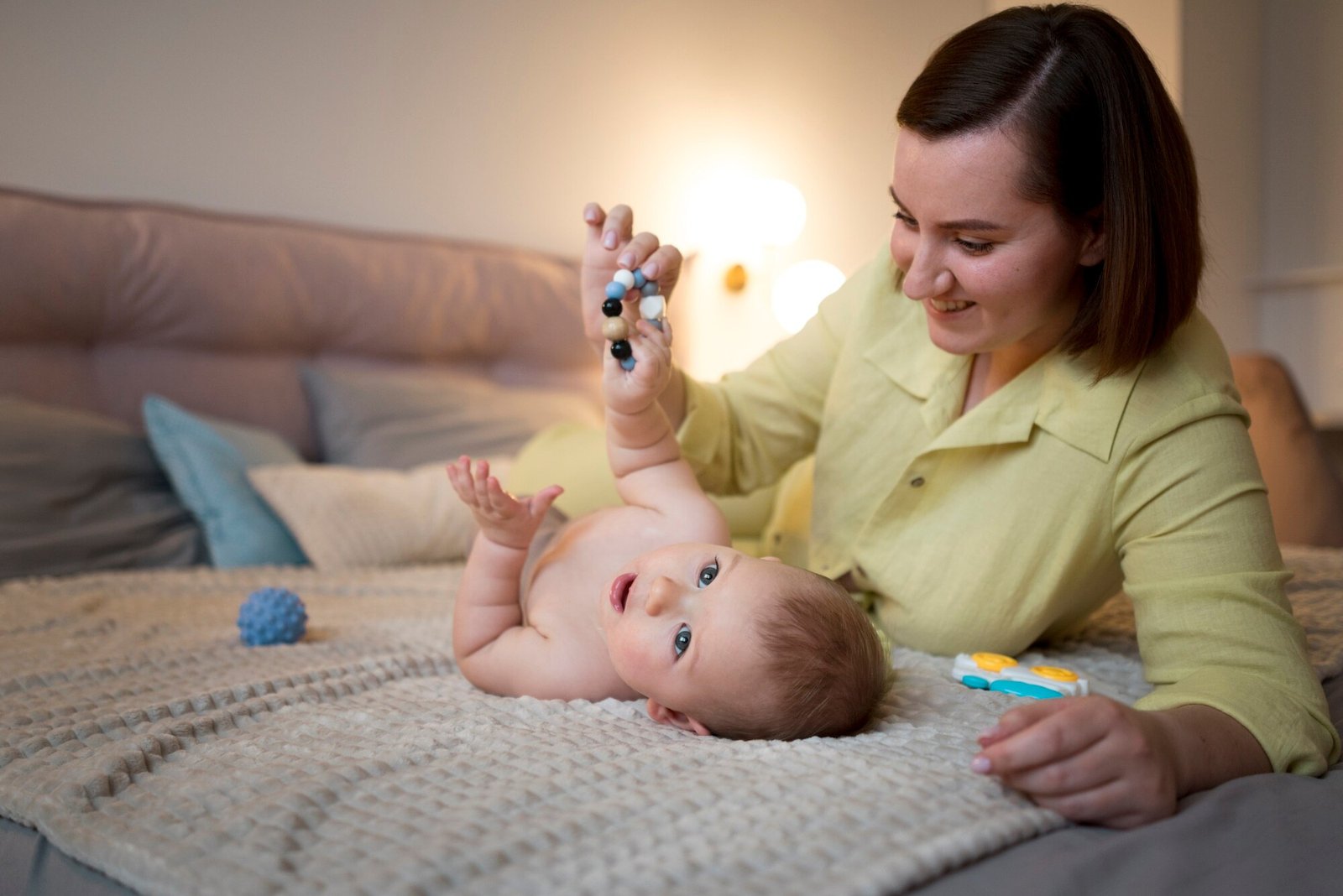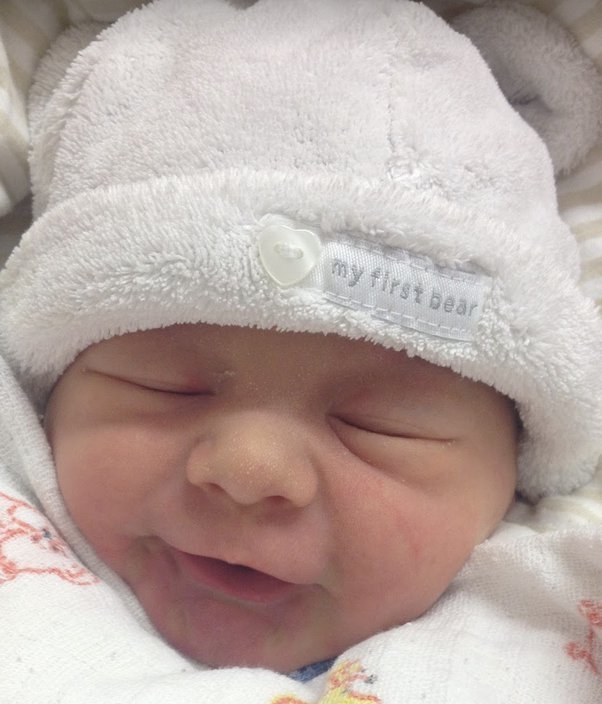You’re Not Imagining It — Your Baby’s Sleep Pattern Is Upside Down
If your newborn is sleeping peacefully through the day, like an angel who couldn’t possibly cause chaos, and then becomes wide-eyed and restless all night long, you’re not alone. This “night shift baby” routine is surprisingly common. And while it feels frustrating (and exhausting), it usually comes down to one thing: your baby doesn’t know what day or night actually means yet.
This early sleep flip has a name — day-night confusion — and it happens because your baby’s internal sleep system hasn’t kicked in yet. Their brain doesn’t recognize sunrise as “wake-up time” or bedtime routines as sleep cues. So they sleep when their body tells them to. Which is…whenever.
Let’s walk through what’s actually happening inside your baby’s body, how long it usually lasts, and how to recognize when it’s improving (or when it might need some help).
Quick Summary:
It’s completely normal for newborns to sleep more during the day and be awake at night in the early weeks. This “day-night confusion” happens because their internal body clock isn’t developed yet. Their sleep is shaped by feeds, comfort needs, and light exposure — not time of day. With consistent routines, bright daytime cues, and calm nighttime habits, most babies begin to adjust their sleep-wake cycle by 6–8 weeks.
Why Do Newborns Sleep All Day and Stay Awake at Night?
Here’s what’s important to understand first: newborns aren’t misbehaving. They’re not “bad sleepers.” They’re just not wired — yet — to follow the same rules you are.
The main reason this sleep flip happens is because they were born without a working circadian rhythm — the internal clock that tells the body when it’s time to be awake and when it’s time to wind down. That system runs off of exposure to light, darkness, feeding routines, and body hormones like melatonin — none of which are developed at birth.
In the womb, there was no day or night in the traditional sense. Your movement lulled them to sleep during the day, and when you stopped moving at night, they often became more active. That rhythm doesn’t just flip the moment they’re born.
Add to that the fact that they’re feeding every couple of hours, need comfort at all hours, and are going through rapid developmental changes — and you’ve got a perfect recipe for an unpredictable sleep schedule.
So yes, it’s normal. And no, you’re not the only parent wondering why your baby is partying at 3am.
How Long Does Day-Night Confusion Last in Newborns?
This phase can feel endless when you’re stuck in it, but it’s usually short-lived.
Most newborns begin to adjust by 6 to 8 weeks, sometimes sooner. You might notice a change in sleep behavior as early as 3–4 weeks if you’re using consistent routines and giving clear daytime and nighttime cues. Some babies take a little longer — especially if they’re premature or have reflux or feeding sensitivities that interfere with sleep.
You’ll often see a slow shift:
- Night wakings become less intense
- Feeds space out just slightly
- Naps start to happen in smaller chunks during the day
- The “wide awake” period gradually moves earlier
Just keep in mind: even once day-night confusion improves, your baby will still wake up at night. That’s developmentally normal. The goal is to help their body know that nighttime is for resting, even if it involves feeds — and daytime is when the world is bright, noisy, and a little more active.
Signs That Your Baby’s Sleep Is Flipped
You probably don’t need a checklist to know something’s off — you’re living it. But here are the most common signs of a day-night reversal:
- Long, deep sleep stretches during the day — they snooze through loud TVs, doorbells, even diaper changes
- Wide awake stretches at night — they’re alert, curious, or fussy between 12am and 5am
- More frequent feeds after midnight — cluster feeding tends to hit hard at night
- Harder time settling in the bassinet at night — but during the day, they’ll nap anywhere
- They fall asleep in your arms, but wake instantly once laid down after dark
You may also notice your baby sleeps through the day’s chaos but needs everything just right at night — perfect swaddle, complete silence, and the exact angle in your arms to doze off. That’s a sign their system hasn’t fully understood that nighttime is for winding down yet.
What’s Normal — and What Might Be Worth a Closer Look
In most cases, there’s nothing to worry about. Day-night confusion isn’t dangerous — it’s just inconvenient. As long as your baby is feeding well, gaining weight, producing wet diapers, and having moments of alertness during the day, this is just a developmental phase.
But if you’re seeing the following, it’s worth checking in with your pediatrician:
- The flipped pattern continues past 10–12 weeks with no signs of shifting
- Your baby stays awake for more than 5–6 hours overnight and seems miserable
- Feeds are inconsistent or your baby is too sleepy to feed well during the day
- Weight gain has plateaued or slowed noticeably
- Your baby seems overtired, overstimulated, or unable to nap at all — day or night
A pediatrician can rule out feeding issues, reflux, or underlying sleep disruptions and offer some personalized strategies if the adjustment isn’t happening naturally.
How to Help Your Newborn Understand the Difference Between Day and Night
You can’t force a newborn to sleep when you want them to — but you can create an environment that nudges their internal clock in the right direction.
Think of it like this: their brain is still under construction. What you do now — how you light the room, how you feed, how you respond — becomes the blueprint their body starts to follow over the coming weeks. It won’t flip overnight, but consistency makes a difference.
Let’s break this down into simple things that actually work.
Help Them Feel the Day
The goal during the day isn’t to keep them awake — it’s to help them register that this time feels different from night.
Let them nap when they’re tired, but don’t turn your house into a sleep cave.
- Keep curtains open.
- Let in natural sunlight.
- Use your regular speaking voice.
- Don’t tiptoe around.
Hold feeds near a window. Take them outside, even for five minutes. Talk to them during diaper changes. Basically, let daytime feel active, bright, and stimulating in a low-key, baby-appropriate way.
If your baby naps for more than 2.5 to 3 hours at a time during the day, gently wake them. Offer a feed, give a little movement or playtime, and reset. Long naps sound like a gift in the moment — but they can steal the pressure that helps them sleep better at night.
Set a Soothing, Predictable Night Routine
At night, your goal is to shift into low-sensory mode. The message is simple: it’s dark, it’s quiet, it’s time to rest.
That doesn’t mean long bedtime routines — just small, repeatable habits.
Give a warm bath, dim the lights, swaddle, feed quietly, hold them with low movement. No singing. No bouncing. No chit-chat. Just calm presence.
During night feeds:
- Keep lights off or use a soft red or amber nightlight
- Don’t talk unless needed — use quiet hums or soft “shhh” sounds
- Avoid changing diapers unless it’s a poop
- Don’t play or engage — just feed, burp, hold, back to bed
This is how babies begin to associate nighttime with rest — even if they’re still waking frequently.
Ease the Bassinet Struggle
One of the biggest pain points at night? You finally get them to sleep, then they wake the second you lay them down.
This is often about timing and temperature. Try this:
- Hold them for an extra few minutes after they fall asleep to ensure they’re in deeper sleep before transfer
- Warm the bassinet with your hand or a warm cloth for a minute before placing them in — cold sheets can shock a sleepy baby awake
- Swaddle snugly if they like it
- Use white noise or soft sleep sounds near the bassinet to soften the transition
Some babies also respond better to being placed on their side first (just for the transfer), then gently rolled to their back once they’re down. It can feel more secure.
Watch for Overtiredness — It Makes Everything Worse
If your baby has stayed awake too long — especially at night — they can become overtired. And that’s when things unravel. Crying escalates, sleep becomes harder to achieve, and the whole night can snowball.
Here’s a simple guide:
- In the first month, babies can usually only stay awake for 45 to 60 minutes at a time
- After that, they need help winding down again — even if it feels too soon
If you’re missing those windows and they’re getting fussy or wired by 10pm, they’re likely too tired — not too energetic. Adjusting their last nap or starting the nighttime wind-down earlier can help.
What Not to Do (That Accidentally Makes It Worse)
This part is important — because it’s easy to do things with the best of intentions that keep the sleep confusion going.
Avoid:
- Keeping the baby in total darkness all day (they need light cues)
- Allowing 4–5 hour naps during the day (they need shorter stretches)
- Keeping them awake for hours thinking it will make them tired at night (overtired babies don’t sleep better — they sleep worse)
- Constant bouncing, rocking, or feeding to sleep at all times — this makes them rely on motion or food to fall back asleep later
Gentle routines and light/dark cues will help their own rhythm take over. It just takes time.
This Isn’t Forever — But It Is Hard
Even with all the right tools and routines, there will be nights that just don’t work. Babies are babies — their systems are still learning, and their needs change week by week.
But most parents who’ve gone through this say the same thing: one day, almost without warning, the 3am wakeups turn into a feed and right back to sleep. Then you blink, and your baby starts sleeping longer stretches — not because of magic, but because of consistency, environment, and time.
You’re not spoiling them. You’re not creating bad habits. You’re guiding a brand new human being through their first big life adjustment: learning the rhythm of the world.
What to Read Next
- Why Is My Baby Crying After Every Feed? – Crying after feeds and night fussiness often go hand in hand.
- Why Do Babies Cry for No Reason? – Understand the common (and confusing) triggers behind baby tears.
- Coming Soon: Best Burping Techniques for Newborns – A simple guide to reduce gas, fussiness, and night wakings.
❓ FAQs
Q1: Can I sleep train a newborn?
No. Sleep training isn’t appropriate for babies under 4 months. But you can start shaping sleep with routines and light cues early on.
Q2: What if nothing I try seems to help?
That’s okay. Some babies take longer. Keep using light during the day and darkness at night, and let your pediatrician know if it continues past 12 weeks with no change.
Q3: Should I let my baby nap in bright rooms or move them to a dark space?
Let them nap in natural light. This helps their brain start recognizing the difference between day and night.
Q1: Can I give my baby a set bedtime during the newborn stage?
Newborns don’t have regular sleep patterns yet, so a strict bedtime often doesn’t work. Instead, aim for a calming routine around the same window of time each evening — this helps their body begin to recognize when night begins.
Q2: Is it okay if my baby only sleeps in the carrier or on me during the day?
Yes, contact naps are completely normal in the first few weeks. While bassinet naps are ideal long term, daytime snuggles can actually help regulate your baby’s nervous system and sleep development early on.
Q3: How do I know if my baby is getting enough sleep overall?
Most newborns sleep 14–17 hours in 24 hours. If your baby is alert during wake windows, feeding well, gaining weight, and not overly fussy all day, they’re likely getting enough — even if sleep is broken into unpredictable chunks.
Q4: Should I try to keep my baby awake more during the day?
No. Overtired babies are harder to settle at night. Instead of limiting naps, focus on helping baby wake naturally during the day with light, sound, and activity — then let them rest when they need to.









